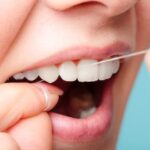
Dental floss is an essential tool in maintaining good oral health. It is a thin, flexible, and usually made of nylon or plastic. Flossing helps to clean between the teeth and remove debris and plaque that a toothbrush cannot reach.Many people do not realize the importance of flossing. Brushing alone cannot clean all surfaces of the teeth, especially the narrow spaces between the teeth and the gumline. Leaving these areas unclean can result in gum disease and tooth decay.To use dental floss properly, start by breaking off about 18 inches of floss. Wrap the floss around your fingers, leaving a gap of a few inches in the middle. Hold the floss tightly between your thumb and forefinger, and gently insert it between the teeth using a back and forth motion. Curve the floss into a C shape around the tooth and gently slide it under the gumline. Repeat this process for each tooth, using a clean section of floss each time.There are different types of dental floss, including waxed and unwaxed, flavored and unflavored, and tape or floss picks. It is important to use the type of floss that works best for you and your dental needs.
Waxed floss is coated with wax for a smoother glide, making it easier to use, especially if you have tight spaces between your teeth. Unwaxed floss is thinner and may work better for people with larger gaps between their teeth. Flavored floss can make flossing more enjoyable, and tape floss is wider and may be more comfortable for those with sensitive gums.
For those who find using traditional floss difficult, floss picks are a great alternative. They are small, plastic tools that hold a piece of floss between two prongs, making it easy to reach the back of the mouth or other hard-to-reach places.
Flossing should be done at least once a day, ideally before bedtime or after each meal. After flossing, rinse your mouth with water or mouthwash to help remove any loosened debris or bacteria.
In addition to flossing, it is important to maintain a regular oral hygiene routine, including brushing twice a day with fluoride toothpaste and visiting your dentist regularly for checkups and cleanings. By incorporating dental floss into your daily routine, you can help prevent oral health issues and keep your teeth and gums healthy for a lifetime.
